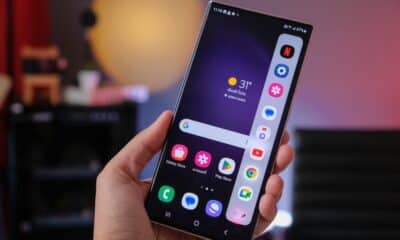Phones
Android 15 vs. iOS 18: A Tough Competition
Google’s Android 15 and Apple’s iOS 18 represent the most recent versions of the leading mobile operating platforms globally. Each introduces an array of innovations and refinements, highlighting unique selling points and strong suits. The video underneath offers a detailed juxtaposition of these systems, delving into core facets such as tailoring options, control hubs, gaming modalities, communicative functionalities, image and electronic mail applications, securing and hiding applications, as well as AI amalgamations, amongst others. Recognizing the shared traits and distinctions between iOS 18 and Android 15 allows you to choose the one that resonates with your personal requirements.
Broad Personalization Abilities
Enhanced personalization functionalities mark a significant augmentation in both Android 15 and iOS 18. The latter now provides greater liberty in placing widgets and applications across the home interface, edging nearer to the versatility that has come to be associated with Android. The option for dark theme application and harmonious coloration of icons and widgets bolsters the cohesive visual presentation and allure of your gadgets. Moreover, iOS 18 offers increased detail in customizing the lock interface, enabling tailored alerts and direct access settings suited to user inclinations. Such an expanded capacity to modify ensures the device embodies your own taste and requirements.
Streamlined Control Hubs
The Control Hubs for iOS 18 and Android 15 have both received significant refinements, improving the overall user interactions. Notably, iOS 18’s Control Center is now more navigable and configurable than its counterpart in Android, known as Quick Settings. iOS 18 enables greater ease in resizing and differentiating of control elements through coloring, enhancing the intuition and speed with which one can reach commonly adjusted settings. This meticulous attention towards ease and functionality is reflective of Apple’s design ethos.
Custom-Tailored Gaming Environments
The phenomenon of gaming on handheld devices has seen a surge in popularity, prompting both platforms to innovate accordingly. With the introduction of a rudimentary gaming mode, iOS 18 focuses on honing performance and minimizing disruptions for a seamless and concentrated game-play routine. Conversely, Android 15 elevates this by presenting a more intricate gaming mode replete with augmented graphical and performance adjustments, catering particularly to avid gamers seeking optimal device output.
Augmented Communicative Functions
Communicative capabilities have seen substantial elevation in both Android 15 and iOS 18. Apple’s exclusive messaging platform, iMessage, now amalgamates emoji-based reactions, timing features for message dispatch, and RCS compatibility, aligning it more suitably with the functionalities seen on Android’s communicative apps. These integrations contribute to a more dynamic and seamless interaction experience. iMessage sets itself apart with text animations and satellite-powered messaging, broadening avenues for expression and connectivity in situations where regular network service is absent.
AI-Enhanced Image Organization
Photos applications on both iOS 18 and Android 15 now harness artificial intelligence to improve the management and editing of pictures. The AI advancements in iOS 18’s Photos application simplify the tasks involved with sorting and refining your cherished photographic moments. Android 15 heralds the AI Gemini feature, drastically enhancing the photo lookup feature. AI Gemini aids in swiftly pinpointing precise snapshots based on various criteria like items, folks, or settings, reducing the time invested in navigating the image archive.
More Effective Email Application Improvements
Email applications on both operating systems have seen impressive improvements. The Apple Mail on iOS 18 introduces classifications and AI-driven functionalities akin to those present in Gmail, aiding users in more efficiently sorting and prioritizing emails. Innovations such as condensed views and intelligent response suggestions expedite the email handling process by encapsulating essential details and proposing prompt replies. These advancements significantly optimize your email management, letting you prioritize your main concerns.
Robust Application Protection and Concealment
Given the prevalent emphasis on privacy and data protection, both iOS 18 and Android 15 extend features for the concealment and safeguarding of applications to mitigate these concerns. Both ecosystems facilitate the ability to lock and obscure access to sensitive applications, with Android 15 presenting an advanced compartmented space for greater security. Such provisioned layers of defense ensure that your private data remains shielded from uninvited access.
Efficient AI Integration
AI integration constitutes a focal point for both iOS 18 and Android 15, leveraging machine intelligence to bolster various facets of the user experience. On iOS 18, artificial intelligence is deployed to manage notifications, create imagery, and upgrade Siri’s capabilities, empowering the devices to become more insightful and supportive in assisting users. Android 15’s AI Gemini furnishes practical utilities like video abridgement and protection against deceitful calls, offering both time savings and defense against potential threats. These smart features reflect the ongoing evolution of both platforms to adapt to users’ evolving demands.
iOS 18 introduces additional explorations for hiking trails in Maps, improves Apple Cash transactions, and debuts a novel Journal application. Android 15 enhances the functionality of split-view, adjusts the volume control panel, refines default application settings, and unveils a computer-like desktop mode.
Distinguishing Features for Each OS
Although sharing quite a few features, both iOS 18 and Android 15 also bring unique attributes. iOS 18 enriches the Maps with trails for hikers, enabling the discovery of outdoor escapades. Furthermore, it facilitates Apple Cash transmissions amongst peers, and presents a refreshed Journal application for documenting reflections and notes. In contrast, Android 15 betters its multi-screen utilization, thereby advancing multitasking capabilities. It also refines adjustments to volume and app defaults, providing better command of the device’s auditory interface and software inclinations. Most notably, a newly integrated desktop mode in Android 15 transforms your smartphone into a provisional computing station upon connection to an external screen.
Privacy and Authorization Settings
Privacy remains a critical element of focus in both iOS 18 and Android 15. The former enhances the granularity of permissions related to contacts, granting users the power to dictate access to their personal information. Considering the modern-day significance and fragility of personal data, this precision is essential. Android 15, meanwhile, brings to the fore adaptive and custom patterns for vibrations, enriching the personal experience and safeguarding confidentiality. Such features allow for discernment of different alert types without the need to glance at the device, conserving privacy even when out and about. To sum up, iOS 18 espouses improvements in AI, crafting a user-tailored atmosphere, and upholds privacy, while Android 15 favors multitasking, screen controls, and distinct offerings such as the desktop mode. The decision between the two depends on individual necessities, predilections, and the digital ecosystem one is most at ease within. Opting for iOS’s smooth design and intuitive experience or Android’s adaptability and customization, both operating systems come forth with a package embracing features that serve diverse user bases. Weighing the singular strengths and characteristics of each platform allows for a calculated selection, aligning with your day-to-day needs and ambitions.















